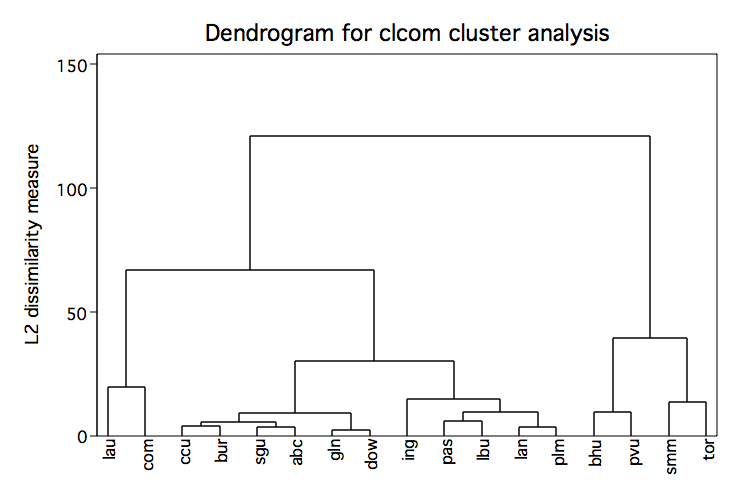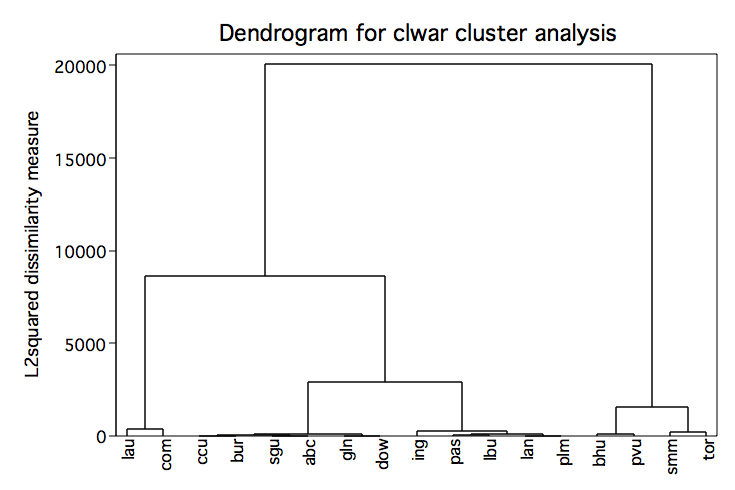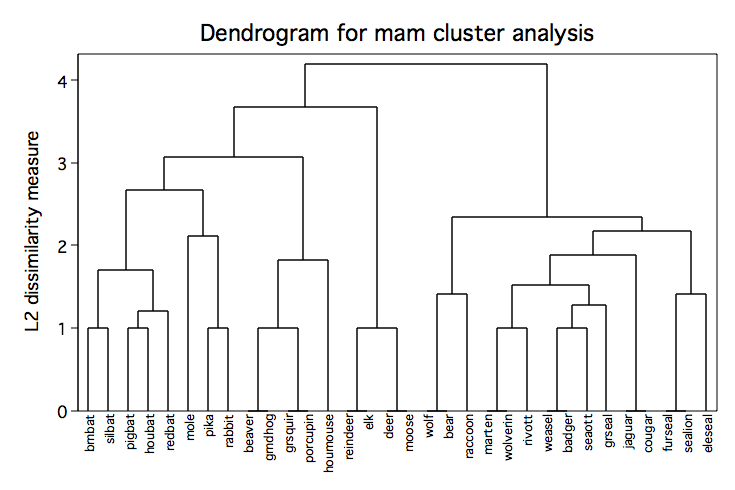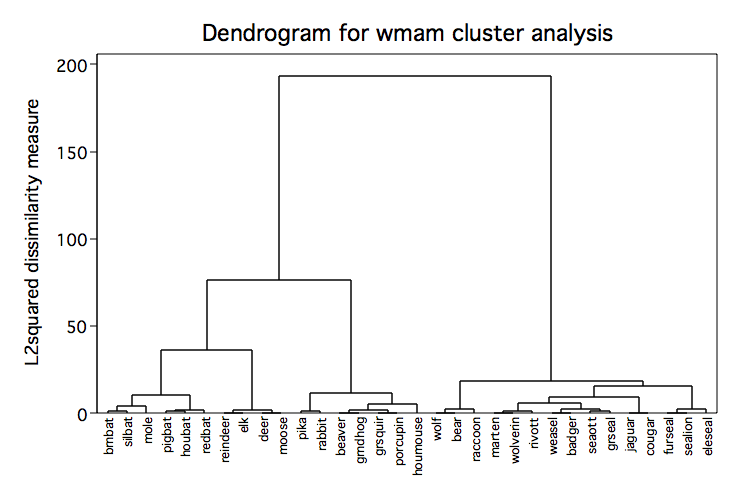
Hierarchical cluster analysis is comprised of agglomerative methods and divisive methods that finds clusters of observations within a data set. The divisive methods start with all of the observations in one cluster and then proceeds to split (partition) them into smaller clusters. The agglomerative methods begin with each observation being considered as separate clusters and then proceeds to combine them until all observations belong to one cluster. Four of the better known algorithms for hierachical clustering are average linkage, complete linkage, single linkage and Ward's linkage.
Average linkage clustering uses the average similarity of observations between two groups as the measure between the two groups. Complete linkage clustering uses the farthest pair of observations between two groups to determine the similarity of the two groups. Single linkage clustering, on the other hand, computes the similarity between two groups as the similarity of the closest pair of observations between the two groups.
Ward's linkage is distinct from all the other methods because it uses an analysis of variance approach to evaluate the distances between clusters. In short, this method attempts to minimize the Sum of Squares (SS) of any two (hypothetical) clusters that can be formed at each step. In general, this method is regarded as very efficient, however, it tends to create clusters of small size.
Hierarchical Cluster Analysis Example
1998 test data from 17 school districts in Los Angeles County were used. The variables were:
lep - Proportion of LEP students to total tested
read - The Reading Scaled Score for 5th Grade
math - The Math Scaled Score for 5th Grade
lang - The Language Scaled Score for 5th Grade
The districts were:
lau - Los Angeles
ccu - Culver City
bhu - Beverly Hills
ing - Inglewood
com - Compton
smm - Santa Monica Malibu
bur - Burbank
gln - Glendale
pvu - Palos Verdes
sgu - San Gabriel
abc - Artesia, Bloomfield, and Carmenita
pas - Pasadena
lan - Lancaster
plm - Palmdale
tor - Torrance
dow - Downey
lbu - Long Beach
We will compare the four cluster solutions for each of the cluster methods.
Average Linkage Cluster Analysis in Stata
input lep read math lang str3 district .38 626.5 601.3 605.3 lau .18 654.0 647.1 641.8 ccu .07 677.2 676.5 670.5 bhu .09 639.9 640.3 636.0 ing .19 614.7 617.3 606.2 com .12 670.2 666.0 659.3 smm .20 651.1 645.2 643.4 bur .41 645.4 645.8 644.8 gln .07 683.5 682.9 674.3 pvu .39 648.6 647.8 643.1 sgu .21 650.4 650.8 643.9 abc .24 637.0 636.9 626.5 pas .09 641.1 628.8 629.4 lan .12 638.0 627.7 628.6 plm .11 661.4 659.0 651.8 tor .22 646.4 646.2 647.0 dow .33 634.1 632.0 627.8 lbu end cluster average lep read math lang, name(clav) cluster tree clav, label(district) xlabel(,angle(90))

cluster gen ave4=groups(4) sort ave4 list ave4 district, sepby(ave4) noobs +-----------------+ | ave4 district | |-----------------| | 1 lau | | 1 com | |-----------------| | 2 bhu | | 2 pvu | |-----------------| | 3 tor | | 3 smm | |-----------------| | 4 ccu | | 4 plm | | 4 sgu | | 4 abc | | 4 lan | | 4 gln | | 4 bur | | 4 dow | | 4 lbu | | 4 pas | | 4 ing | +-----------------+Complete Linkage Cluster Analysis in Stata
cluster complete lep read math lang, name(clcom) cluster tree clcom, label(district) xlabel(,angle(90))

cluster gen com4=groups(4) sort com4 list com4 district, sepby(com4) noobs +-----------------+ | com4 district | |-----------------| | 1 com | | 1 lau | |-----------------| | 2 abc | | 2 sgu | | 2 lan | | 2 plm | | 2 dow | | 2 pas | | 2 ccu | | 2 ing | | 2 bur | | 2 gln | | 2 lbu | |-----------------| | 3 bhu | | 3 pvu | |-----------------| | 4 tor | | 4 smm | +-----------------+Single Linkage Cluster Analysis in Stata
cluster single lep read math lang, name(clsin) cluster tree clsin, label(district) xlabel(,angle(90))

cluster gen sin4=groups(4) sort sin4 list sin4 district, sepby(sin4) noobs +-----------------+ | sin4 district | |-----------------| | 1 com | |-----------------| | 2 lau | |-----------------| | 3 pvu | | 3 bhu | |-----------------| | 4 gln | | 4 dow | | 4 pas | | 4 lan | | 4 abc | | 4 tor | | 4 ccu | | 4 bur | | 4 sgu | | 4 ing | | 4 lbu | | 4 smm | | 4 plm | +-----------------+Ward's Method Cluster Analysis in Stata
cluster wards lep read math lang, name(clwar) cluster tree clwar, label(district) xlabel(,angle(90))

cluster gen ward4=groups(4)
sort ward4
list ward4 district, sepby(ward4) noobs
+------------------+
| ward4 district |
|------------------|
| 1 com |
| 1 lau |
|------------------|
| 2 gln |
| 2 dow |
| 2 abc |
| 2 bur |
| 2 sgu |
| 2 ccu |
|------------------|
| 3 lan |
| 3 lbu |
| 3 pas |
| 3 ing |
| 3 plm |
|------------------|
| 4 pvu |
| 4 bhu |
| 4 smm |
| 4 tor |
+------------------+
tabstat lep read math lang, by(ward4) stat(n mean sd)
Summary statistics: N, mean, sd
by categories of: ward4
ward4 | lep read math lang
---------+----------------------------------------
1 | 2 2 2 2
| .285 620.6 609.3 605.75
| .1343503 8.343851 11.31371 .6364134
---------+----------------------------------------
2 | 6 6 6 6
| .2683333 649.3167 647.15 644
| .1030372 3.182703 2.013696 1.769748
---------+----------------------------------------
3 | 5 5 5 5
| .174 638.02 633.14 629.66
| .1069112 2.712385 5.364979 3.702434
---------+----------------------------------------
4 | 4 4 4 4
| .0925 673.075 671.1 663.975
| .0262996 9.491522 10.65865 10.31613
---------+----------------------------------------
Total | 17 17 17 17
| .2011765 648.2059 644.2118 639.9824
| .1148304 17.57874 20.30782 18.81831
--------------------------------------------------
xi: mvreg lep read math lang = i.ward4
i.ward4 _Iward4_1-4 (naturally coded; _Iward4_1 omitted)
Equation Obs Parms RMSE "R-sq" F P
----------------------------------------------------------------------
lep 17 4 .0956469 0.4363 3.353913 0.0523
read 17 4 5.683735 0.9151 46.68266 0.0000
math 17 4 6.817553 0.9084 42.98923 0.0000
lang 17 4 5.478383 0.9311 58.59633 0.0000
------------------------------------------------------------------------------
| Coef. Std. Err. t P>|t| [95% Conf. Interval]
-------------+----------------------------------------------------------------
lep |
_Iward4_2 | -.0166667 .0780954 -0.21 0.834 -.1853815 .1520482
_Iward4_3 | -.111 .080024 -1.39 0.189 -.2838812 .0618812
_Iward4_4 | -.1925 .0828327 -2.32 0.037 -.3714491 -.0135509
_cons | .285 .0676326 4.21 0.001 .1388887 .4311113
-------------+----------------------------------------------------------------
read |
_Iward4_2 | 28.71666 4.64075 6.19 0.000 18.69093 38.7424
_Iward4_3 | 17.41999 4.755354 3.66 0.003 7.146672 27.69331
_Iward4_4 | 52.47501 4.922259 10.66 0.000 41.84111 63.1089
_cons | 620.6 4.019007 154.42 0.000 611.9175 629.2825
-------------+----------------------------------------------------------------
math |
_Iward4_2 | 37.85001 5.566509 6.80 0.000 25.82429 49.87572
_Iward4_3 | 23.84001 5.703974 4.18 0.001 11.51733 36.1627
_Iward4_4 | 61.80002 5.904174 10.47 0.000 49.04483 74.55521
_cons | 609.3 4.820738 126.39 0.000 598.8854 619.7146
-------------+----------------------------------------------------------------
lang |
_Iward4_2 | 38.25 4.473081 8.55 0.000 28.5865 47.9135
_Iward4_3 | 23.91 4.583544 5.22 0.000 14.00785 33.81214
_Iward4_4 | 58.22499 4.744419 12.27 0.000 47.9753 68.47468
_cons | 605.75 3.873802 156.37 0.000 597.3812 614.1188
------------------------------------------------------------------------------
Average Linkage Cluster Analysis for Mammal Data
use http://www.gseis.ucla.edu/courses/data/mammal, clear
format v1- v8 %2.0f
list ,noobs nodis
mammal v1 v2 v3 v4 v5 v6 v7 v8
brnbat 2 3 1 1 3 3 3 3
mole 3 2 1 0 3 3 3 3
silbat 2 3 1 1 2 3 3 3
pigbat 2 3 1 1 2 2 3 3
houbat 2 3 1 1 1 2 3 3
redbat 1 3 1 1 1 2 3 3
pika 2 1 0 0 2 2 3 3
rabbit 2 1 0 0 3 2 3 3
beaver 1 1 0 0 2 1 3 3
grndhog 1 1 0 0 2 1 3 3
grsquir 1 1 0 0 1 1 3 3
houmouse 1 1 0 0 0 0 3 3
porcupin 1 1 0 0 1 1 3 3
wolf 3 3 1 1 4 4 2 3
bear 3 3 1 1 4 4 2 3
raccoon 3 3 1 1 4 4 3 2
marten 3 3 1 1 4 4 1 2
weasel 3 3 1 1 3 3 1 2
wolverin 3 3 1 1 4 4 1 2
badger 3 3 1 1 3 3 1 2
rivott 3 3 1 1 4 3 1 2
seaott 3 2 1 1 3 3 1 2
jaguar 3 3 1 1 3 2 1 1
cougar 3 3 1 1 3 2 1 1
furseal 3 2 1 1 4 4 1 1
sealion 3 2 1 1 4 4 1 1
grseal 3 2 1 1 3 3 2 2
eleseal 2 1 1 1 4 4 1 1
reindeer 0 4 1 0 3 3 3 3
elk 0 4 1 0 3 3 3 3
deer 0 4 0 0 3 3 3 3
moose 0 4 0 0 3 3 3 3
cluster average v1- v8, name(mam)
cluster tree mam, label(mammal) xlabel(,angle(90) labsize(*.75))

Ward's Method Cluster Analysis for Mammal Data
cluster wards v1- v8, name(wmam) cluster tree wmam, label(mammal) xlabel(,angle(90) labsize(*.75))

Example Using Fisher Iris Data
use http://www.gseis.ucla.edu/courses/data/iris
cluster average sl sw pl pw, name(c1)
cluster gen c1=groups(3), name(c1)
tabulate c1 type
| type of iris
c1 | setosa versicolo virginica | Total
-----------+---------------------------------+----------
1 | 50 0 0 | 50
2 | 0 50 14 | 64
3 | 0 0 36 | 36
-----------+---------------------------------+----------
Total | 50 50 50 | 150
cluster wards sl sw pl pw, name(wcl)
cluster gen wcl=groups(3), name(wcl)
tabulate wcl type
| type of iris
wcl | setosa versicolo virginica | Total
-----------+---------------------------------+----------
1 | 50 0 0 | 50
2 | 0 49 15 | 64
3 | 0 1 35 | 36
-----------+---------------------------------+----------
Total | 50 50 50 | 150
tabulate c1 wcl
| wcl
c1 | 1 2 3 | Total
-----------+---------------------------------+----------
1 | 50 0 0 | 50
2 | 0 63 1 | 64
3 | 0 1 35 | 36
-----------+---------------------------------+----------
Total | 50 64 36 | 150
The Ward's method and average linkage clustering produce almost identical clusters for
the Fisher Iris data.
Multivariate Course Page
Phil Ender, 29Jan98